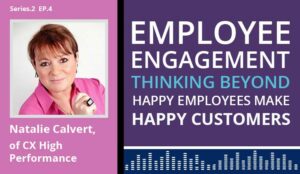The world of work is changing at an unprecedented rate — and it’s never been more important to understand just what employees want and need.
Recent disruptions have left a lasting impression, prompting employees to reevaluate the core aspects of their organizations and reflect on the significance and impact of work in their lives.
Employee experience (EX) is a journey that begins the moment someone is recruited and ends when they move on to the next opportunity. According to Gallup, an exceptional experience is the result of “frequent, meaningful interactions over the course of their employment.”
That experience is shaped by the employee’s manager, role in the organization, the team they work on, their workspace, and their well-being.
From achieving a healthy work-life balance and fair compensation to ensuring job security and aligning personal values with organizational goals, employees are questioning the very foundations of the companies they are associated with.
This introspection has led them to a clear realization: it is high time to reshape their relationship with work and cultivate practices that prioritize human well-being. These practices not only enable individuals to overcome challenges but also empower them to thrive in the contemporary work landscape.
Many CX leaders are still figuring out the best ways to measure EX. And it’s worth the effort because organizations that focus on improving EX have discovered that it not only enhances their teams’ productivity, retention, and engagement but is also the key driver of customer experience (CX) and overall organizational performance.
Let’s dive in and explore how organizations can prioritize identifying and transforming employee journeys to unlock significant improvements in both EX and CX.
The Parallels Between EX and CX
A fantastic employee experience brings advantages that extend beyond just attracting talented individuals. When companies prioritize the well-being of their employees, it pays off in improved customer experiences as well.
Consider the workforce challenges that currently trouble most companies: the lack of skilled workers who can meet the new demands of business, high turnover rates that result in costly recruitment and training processes, and difficulties in engaging employees due to hybrid and other evolving work arrangements, heightened expectations for authentic diversity, equity, and inclusion practices, and significant shifts in workers’ values.
Amid all these challenges, companies struggle to ensure they have a knowledgeable, experienced, and motivated workforce capable of delivering exceptional customer experiences. The importance of EX has grown significantly for customers.
With more customers seeking to align their purchasing decisions with their values, they are increasingly interested in how companies engage with and value their employees.
Customers tend to prioritize doing business with organizations that treat their employees fairly, value their well-being, and prioritize their overall satisfaction.
Furthermore, as employees interact more directly with customers, the nature of employee engagement has a greater impact on the overall customer experience.
Let’s take your sales team as an example: When they receive the support and growth opportunities they desire, they become more motivated to go above and beyond for their clients.
According to a study by PwC, companies that invest in and deliver exceptional experiences to both consumers and employees can command a premium of up to 16% for their products and services.
Moreover, researchers at MIT have found that companies in the top quartile of employee experience development achieve greater success in innovation, generating twice the revenue from their innovations compared to those in the bottom quartile.
Additionally, their industry-adjusted Net Promoter Scores (NPS) are twice as high, indicating stronger customer loyalty and advocacy.
What Is the Employee Journey?
Every individual embarks on a journey within your organization, starting from day one. Every single interaction, every single moment employees have with your brand influences whether they’ll stay with your organization.
From Instagram posts to Slack conversations, the experiences employees have with your organization truly do shape how they feel about it.
But have you ever wondered what this journey truly entails? And more importantly, have you considered how you can enhance it? The impact of an employee’s journey cannot be overestimated. It holds the key to retaining exceptional talent, igniting their passion, and driving productivity.
Studies reveal that organizations emphasizing employee experience outperform their competitors by an astounding 122%. So, why aren’t more companies prioritizing the employee journey?
Employee journey mapping is a process that unravels every interaction and connection an employee has with your organization.
A positive employee journey paves the way for engaged and efficient employees. When individuals feel supported and appreciated, they are inclined to go above and beyond in their work. It’s a win-win situation for all involved.
Seven Stages of the Employee Journey
The impact of EX at every stage has a direct influence on both their performance and your employer branding.
When organizations view their current processes through the lens of employee experience, they may consider the following questions:
- Attract: What aspects of our company culture do we emphasize to attract top talent?
- Hire: Is our hiring process perceived as fair? Does it identify exceptional individuals?
- Onboard: Do we validate the choice employees made to join us? Do new hires experience our values during the onboarding process?
- Engage: Do our employees come to work with enthusiasm and dedication? Do we foster their strengths and sense of purpose?
- Perform: Are our performance reviews unbiased and accurate? Are we setting higher expectations?
- Develop: Do our top performers envision a future with us? Do we provide flexible and personalized career paths? Do we consistently support their career growth?
- Depart: Who are our competitors in terms of talent? Why do our most talented individuals leave? Does our exit program leave a positive impression?
How to Optimize Your Employee Journeys
Let’s dive into the steps you can take to shape an exceptional EX that brings about tangible and lasting benefits.
Start by Measuring Moments That Matter
Mapping the employee life cycle allows you to gauge the employee experience, identifying key moments that drive engagement and areas that require improvement.
This involves gathering comprehensive data, including primary survey insights and external feedback from social platforms. By taking this holistic and objective approach, leaders gain valuable insights into:
- Moments that hold the most significance for employees.
- Successful strategies and highlights worth replicating.
- Blind spots and factors that could lead to turnover.
When you study how employees navigate through the various stages of their journey within the organization, you may uncover shortcomings in specific areas.
For example, your hiring process may be top-notch, but your onboarding program might fail to foster connections between new hires and mentors or colleagues. Alternatively, employees might be highly engaged but lack visibility into their growth and advancement opportunities.
Ensure Your EX Aligns With Your Brand’s Purpose and Culture
This is where comprehensive analytics truly shine. Data-driven insights help leaders align their organization’s unique purpose, brand, and culture with EX.
When your employee journey truly reflects the values and mission of your organization, every interaction with employees becomes authentic, inspiring commitment and driving performance.
Consider how your onboarding program showcases your commitment to customer-centricity if your core values revolve around customers. And how does the customer factor into employees’ performance evaluations?
When every aspect of the employee journey is deeply rooted in your organization’s identity, it creates a cohesive experience where every interaction reinforces the greater whole.
Focus on Hiring, Training, and Developing Exceptional Managers
Your managers play a crucial role in delivering an outstanding employee experience. They are responsible for engaging employees, coaching for high performance, and fostering individualized long-term development.
The quality of employees’ experiences and the fulfillment of their basic needs are ultimately shaped by the leadership abilities of your managers.
Investing in proven manager development programs will prepare and inspire your managers to have effective conversations and consistently help employees recognize their current and future value to the organization.
Don’t leave the most vital interactions between employees and employers to chance. Meaningful and effective hiring and onboarding processes are essential for setting people up for success.
Equally important are the manager interactions focused on engagement, performance, development, and retention. Exceptional leaders understand the interconnected nature of these milestones and ensure that their employer brand promises are upheld at every turn.
Small Changes Make a Big Difference
There are numerous opportunities for employers to create tangible improvements and prevent the negative impact of low engagement.
Employees, especially disengaged employees, often have clear ideas about what they would like to change in their workplace. They desire a better organizational culture, improved compensation and benefits, and a greater emphasis on well-being and work-life balance.
Managers can play a crucial role in enhancing employee engagement. To accomplish this, implementing a simple yet effective framework or checklist of actions enable managers to see and listen to their teams while consistently fulfilling their roles.
A straightforward approach to enhancing employee engagement is for managers to have at least one meaningful conversation per week with their team members.
These conversations can last as little as 15 minutes and serve as an opportunity to recognize employees’ achievements and address their concerns. A Salesforce study found employees who feel a sense of belonging are 5.3 times more likely to feel empowered to perform their best work.
When people can feel connected and supported at work, they’re more productive, efficient, and creative. And with most employees now experiencing work through a digital-first lens, it is the building of these digital employee touchpoints that will be crucial to any good experience of work.
Three Ways to Use Artificial Intelligence (AI) to Improve EX
By automating administrative tasks, personalizing learning experiences, and facilitating agile decision-making, organizations can unlock the full potential of their workforce, fostering a culture of engagement, growth, and continuous improvement.
Streamline Onboarding With Hyperautomation
Creating a positive first impression is key to a great employee experience. But the onboarding process can be overwhelming, involving multiple tasks like background checks, equipment requests, software access, payroll setup, and compliance training.
Often, these tasks are scattered across various systems and external vendors, leading to delays in starting dates for new employees.
Hyperautomation simplifies the process for everyone involved in hiring. Instead of manually ensuring the completion of one task before moving on to the next, hyperautomation intelligently tracks the sequence of events and seamlessly progresses the process, ensuring a smooth and prompt onboarding experience for employees.
Use Large Language Models (LLMs) for Survey Insights
Brands can use LLMs and generative AI to gain valuable insights from employee surveys. These powerful tools analyze and predict data trends while providing coherent responses.
Instead of relying on HR managers to manually handle email requests, the AI can efficiently sort through emails, answer some questions, and redirect complex inquiries to the appropriate HR resource, ensuring faster responses.
Furthermore, LLMs and generative AI have potential applications in HR, such as analyzing employee satisfaction surveys and exit interview data.
By identifying patterns and generating sentiment analysis, these AI systems help uncover valuable information about company culture. HR managers can leverage this data to develop strategies that enhance employee engagement and morale.
Help Employees Learn and Grow
AI solutions have the power to help employees grow and excel in their roles. By using AI, you can discover your employees’ strengths and areas for improvement and provide them with the necessary tools and support to develop effectively.
This support not only boosts their confidence and competence but also fosters a culture of engagement and commitment throughout your contact centre.
Showing genuine care and support for your employees’ success and well-being has been shown to strengthen brand loyalty and increase staff retention and tenure.
Happy Employees Equal Happy Customers
Recognizing and reshaping the employee journey is crucial for achieving remarkable CX within organizations.
By understanding the various touchpoints and interactions that employees have throughout their tenure, brands can effectively address pain points, enhance engagement, and cultivate a positive work environment.
By prioritizing employee satisfaction and empowering them to deliver exceptional service, companies can create a virtuous cycle where satisfied employees translate into satisfied customers.
Ultimately, investing in the identification and transformation of employee journeys is a strategic move that propels organizations to deliver outstanding customer experiences.
Author: Guest Author
Published On: 22nd Aug 2023 - Last modified: 9th Dec 2024
Read more about - Guest Blogs, Execs In The Know















